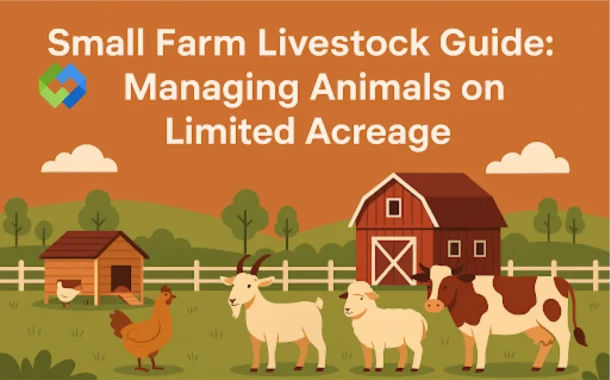Small acreage brings real challenges—mostly around pasture pressure and animal health. But there’s an upside most people miss: you’ll know your animals better, catch problems faster, and build customer relationships that commodity farmers can’t touch.
This guide covers what actually works when you’re managing livestock on limited space. We’ll talk about choosing animals, keeping pastures healthy, and using tools like livestock management software to stay organized without drowning in paperwork.
Table of Contents
Table of Contents
How Much Land Do You Really Need?
Space Requirements by Animal
Let’s skip the sugar-coating. The “one cow per acre” rule? Pretty much useless without context.
Cattle need real space. Figure 1.5-2 acres per cow-calf pair on decent pasture. Bad land or dry climates? You’re looking at 3-5 acres per pair. On a 5-acre property, that means 2-3 animals max.
Goats are your space-efficient option. You can manage 6-8 per acre with decent grazing. They eat brush and weeds cattle ignore, which actually helps on small properties.
Sheep fall in between—plan on 5-6 per acre. They graze efficiently and spread out naturally.
Pigs don’t really pasture. They destroy ground fast. Most small farmers keep them in 1/4-acre paddocks and rotate frequently, supplementing heavily with feed.
Chickens are stupidly flexible. A mobile coop with 25 birds needs maybe 100-150 square feet of coop space. Rotate them daily and they’ll actually improve your pasture.
Rabbits might be the most underrated livestock for small spaces. You can produce serious meat on under 500 square feet with proper colony setups.
Minimum vs. Optimal—There’s a Difference
Minimum stocking keeps animals alive. Optimal stocking keeps them healthy and your land productive.
Push things too hard and you’ll see it fast. Bare patches where grass used to grow. Mud in high-traffic areas even when it hasn’t rained. Animals grazing plants down to dirt, which stresses the grass and tanks nutrient content.
Watch animal behavior too. Comfortable livestock spreads out. If they’re bunching in corners or fighting over specific patches, you’re overstocked.
Most small farmers do better slightly understocking and supplementing with hay than trying to squeeze every possible animal onto every available acre.
Choosing the Right Animals
Dual-Purpose Breeds That Actually Pay
Every animal needs to earn its keep when space is limited.
Dexters deserve serious consideration for cattle. They’re half the size of standard beef breeds but still produce quality meat and decent milk—1-2 gallons daily. Less space, less feed, dual income streams.
Chickens are the obvious winner here. Rhode Island Reds, Plymouth Rocks, Australorps—you’re getting 200+ eggs yearly plus meat when laying drops off.
For sheep, Katahdins and Dorpers are hair sheep (no shearing labor), but if you want wool income, Romney or Corriedale produce good fleeces while finishing well for meat.
What Thrives in Tight Spaces
Temperament matters more than people think. Flighty animals become dangerous when they can’t establish personal space.
Size impacts daily work significantly. A 700-pound Dexter is manageable alone. A 1,400-pound Angus? That’s a different story.
Goats, sheep, and poultry naturally handle confinement better than cattle or pigs. They evolved in rougher, more limited terrain.
What to Skip Initially
Large horse breeds eat like cattle but provide less return unless you’re specifically in the horse business.
Exotic heritage breeds sound appealing but eat up time you don’t have. Master the basics with proven, docile breeds first.
Full-size dairy cows create rigid twice-daily schedules. Miss a milking and you’ve got animal health problems. Goats producing 1-2 quarts are way more forgiving.
Start small. Get comfortable with 4-5 animals before committing to 20.

Pasture Management for Small Acreage
Rotational Grazing Basics
Rotation isn’t optional on small acreage—it’s survival.
Divide available pasture into 4-8 sections using temporary electric fencing. Graze one section for 2-5 days, then move. By the time animals work through all paddocks, the first one’s had 2-4 weeks to recover.
Real example: 4 sheep on 2 acres, 6 paddocks of 1/3 acre each. Sheep graze each paddock 3-4 days, full rotation takes 21 days. That gives each paddock 17-18 days rest before they’re back.
Simple polywire with step-in posts lets you adjust paddock sizes. Spring when grass is growing fast? Smaller paddocks, move every 2-3 days. Late summer when growth slows? Larger paddocks, move less often.
Strip Grazing
Take rotation further. Instead of giving animals a quarter-acre for three days, give them what they’ll eat in one day. Move the fence line daily.
Animals eat everything evenly because they don’t have room to be picky. Grass gets grazed uniformly, rest periods max out.
Don’t overcomplicate calculating capacity. Watch your grass. Growing faster than animals can eat it? Add animals or shrink paddocks. Seeing bare ground? You’re overstocked or moving too slowly.
Rule: Never let animals graze below 3-4 inches. When you hit that height, move them regardless of schedule.
Preventing Overgrazing
Warning signs show up early if you’re watching.
Favorite patches getting hammered while other areas stay lush. Animals spending more time searching for good bites. Grass looking stressed despite adequate moisture. Weeds taking over.
Quick fixes: Reduce stock temporarily. Give paddocks longer rest by feeding hay in a sacrifice area. Reseed thin spots in fall or spring.
Good hay costs less than vet bills from animals eating parasite-laden stressed grass.
Infrastructure on Tight Budgets
Shelter Solutions
You don’t need a fancy barn.
A three-sided run-in shed, 12×12 or 12×16, can shelter several sheep or goats, store hay, and give you workspace. Build it yourself with treated posts, metal roofing, and basic lumber for under $1,500.
Mobile shelters maximize flexibility. Chicken tractors let you move birds to fresh ground every few days. Hoop houses made with cattle panels and tarps work surprisingly well for pigs or sheep.
Animals care about protection from wind, rain, and sun. They don’t care about aesthetics.
Fencing Choices
Permanent perimeter fencing makes sense—woven wire with one strand of barbed or electric on top. Expensive upfront ($3-5 per foot installed) but lasts 20+ years.
Temporary electric fencing transforms small farms. Solar charger runs $150-300. Polywire costs under $50 for 1,000 feet. Step-in posts are $2 each. For a few hundred bucks, you can set up rotational paddocks you can adjust anytime.
Train animals properly to respect electric fencing. Start in smaller spaces where they’ll definitely touch it and learn. Once they respect it, you can use it anywhere.
Water Systems
Hauling water gets old incredibly fast.
Automatic waterers aren’t fancy—they’re survival. Gravity-fed float systems cost $50-150 per unit. Animals get constant clean water. You’re checking daily, not filling buckets twice a day.
On hills, place a 275-gallon IBC tote at the high point, run buried PVC downhill, gravity does the work. Fill weekly. Simple, no electricity, rarely fails.
Winter-proofing means burying lines below frost depth and using insulated waterers in cold climates. They cost $200-400 but prevent frozen pipes and broken equipment.
ROI on automatic water is usually under one season.
Managing Animal Health
The Parasite Problem
This is your biggest health challenge on small acreage. Period.
When animals repeatedly graze the same ground, they’re constantly re-exposed to parasite larvae. Internal parasites complete life cycles in 3-4 weeks. On large pastures with low stocking, it’s manageable. On 5 acres with 10 goats? It’s war.
Move animals off pasture before parasites complete their cycle—3-5 day grazing periods max. Rest paddocks 4-6 weeks in warm weather, longer in cool. Larvae die without hosts.
Don’t deworm on a calendar schedule—that accelerates resistance. Use FAMACHA scoring (checking eyelid color for anemia) to identify which animals actually need treatment.
Fecal testing basics: collect fresh samples from several animals, send to a vet for fecal egg counts. Costs $15-30 per sample. Tells you what parasites you’re dealing with and if your management is working.
Nutrition Without Huge Pastures
Pasture alone won’t cut it, especially seasonally.
Watch body condition scores. Animals should maintain moderate condition—not fat, not ribby. Losing condition on pasture alone? Increase supplementation. Getting too fat? Reduce grain.
Loose minerals formulated for your species should be available free-choice year-round. Cattle need copper. Sheep need copper-free minerals. Deficiencies show up as poor coat, breeding problems, hoof issues.
Quality beats quantity when buying feed. Cheap hay at $5/bale might require twice as much to maintain condition as good hay at $8/bale. Test your hay if buying by the ton. A $30 forage analysis tells you exactly what you’re feeding.
Biosecurity Basics
When you bring in new animals, isolate them 2-3 weeks. A small paddock 30-50 feet from your main pasture works. Watch for coughing, diarrhea, lethargy, unusual discharge. Deworm during quarantine so they don’t bring resistant parasites.
Can’t separate far? At least prevent nose-to-nose contact. Use different water sources and feeding equipment. Wash boots and hands between handling isolated and resident animals.
Good management builds disease resistance. Animals that aren’t stressed, that have good nutrition and clean water, resist disease naturally. Stress breaks down immune systems faster than any pathogen.
Core vaccines for your species and region—CD&T for sheep/goats, blackleg for cattle—are cheap insurance. But you can’t vaccinate your way out of poor management.
Daily Operations and Time
Efficient Feeding Routines
Batch process chores across species. Don’t make separate trips for water, feeding, checking animals. Walk through once in the morning with everything—feed buckets, water hoses, basic first aid—and handle all tasks in one circuit.
Real time commitment for small operations: 30-60 minutes daily for basic care. Add 5-10 hours weekly for fence moving, bedding changes, maintenance. During breeding, lambing, harvest? Spike to 10-15 hours weekly.
Ways to reduce time: smart infrastructure (automatic waterers, efficient fencing), fewer species, calm animals that don’t fight handling.
Observation Skills
Walk through animals once daily. Look for anything different from yesterday.
One goat standing off alone? Usually first sign of illness. Cow limping slightly? Caught early, hoof problems are minor. Caught late, they’re expensive.
Watch how animals eat. Healthy ruminants chew cud while resting. Chickens should be active and foraging. Pigs should come running at feeding time.
Check water sources daily. Empty waterers mean dehydrated animals and production losses.
Early detection saves money and stress. A goat slightly off its feed today might’ve just eaten something disagreeable. Ignored for three days? Pneumonia requiring vet intervention.
Spend two extra minutes watching animals eat during chores. Those two minutes catch most problems while they’re manageable.
Technology That Actually Helps
Modern tools make small farms more manageable than they’ve ever been.
Livestock management software helps track details you can’t afford to lose. Managing breeding schedules for 6 goats, treatment records for 4 cattle, feed costs across species? Paper gets messy fast.
Benefits of farm livestock management software:
- Health records accessible anywhere. Pull up vaccination dates at the farm store or check deworming dates without digging through notebooks.
- Breeding schedule reminders based on species-specific gestation periods. Miss a heat cycle on one of four cows, you’ve lost income and disrupted calving.
- Feed tracking shows cost-per-pound-of-gain across different strategies. You might discover switching hay suppliers saved $0.15/animal/day—multiply across a year, that’s real money.
- Cost analysis proves (or disproves) profitability. Track income against expenses per animal. See which parts carry weight and which are hobbies you’re subsidizing.
Time saved with digital records adds up to several hours monthly—time you can spend on actual farm work. Systems like those at livestock management software platforms bring enterprise-level tracking to any size farm.
Choose software for livestock management designed for your scale. You don’t need systems built for 10,000-head feedlots. You need something tracking 4-40 animals with enough detail to improve decisions without overwhelming you.
Breeding on Small Herds
Should You Even Breed?
Space for pregnant animals and offspring is consideration number one. A cow with a calf needs about 50% more forage than one without. Already at capacity? Breeding means reducing numbers or finding additional grazing.
Whether breeding makes financial sense depends on species and market access. A sheep costing $200 producing 1-2 lambs worth $150 each creates obvious value. A cow costing $1,500 producing a $600-800 calf takes longer to pay back, especially factoring bull costs and additional management.
Many small farmers buy weaned animals, raise to market weight, and sell. Eliminates breeding management entirely. Often works better when learning or when space is truly limited.
Genetics in Small Numbers
Every animal’s genetics impact overall herd quality significantly.
Avoid inbreeding by replacing breeding males every 2-3 years before breeding back to daughters. Track lineages carefully—another area livestock management software solutions help by tracking parentage and flagging too-close breeding combinations.
AI services give small farmers access to top genetics without maintaining males. Semen straws from elite bulls, rams, bucks cost $20-100 per unit. Technician charges $50-75 for insemination. Compare to purchasing, feeding, managing a breeding male year-round, AI makes financial sense.
Birth Timing
Timing matters more on small farms because you’re managing everything yourself. Four cows calving within two weeks means intense work for that period but freedom the rest of the year. Spreading calves across three months means constant vigilance.
Align births with grass growth. Spring calving/lambing/kidding—timed so births happen as grass starts growing vigorously—means mothers have excellent nutrition during lactation without expensive supplementation.
Winter births require better shelter and more stored feed but put market-ready animals available in spring when prices are often higher. Spring births work with nature and require less infrastructure.
For most small farmers with limited facilities, spring birthing makes life easier.
Financial Reality
Break-Even Numbers
Feed typically runs 60-70% of variable costs. A breeding ewe might eat $75-150 in hay and grain annually. A cow might consume $400-800 depending on pasture quality. Vet care adds $20-50 per small animal, $50-150 per cow annually.
Infrastructure spreads over multiple years. Your $2,000 barn serves animals 20 years, so $100 annually. $3,000 fencing lasting 15 years is $200 annually. Equipment, feeders, waterers add another $200-400 yearly.
How many animals justify the effort depends on goals. Farming for personal food production? 2-4 productive animals might be sufficient. Trying to generate income? You probably need 8-12 productive animals before revenue covers costs and provides meaningful return on labor.
Budget an extra 15-20% beyond calculated expenses for surprises—fence repairs, predator losses, equipment replacement, insurance increases.
Direct Marketing Advantages
Customers increasingly want to know where food comes from. They want to meet the farmer, see the farm, feel confident about animal welfare. You can offer that. A 5,000-head feedlot can’t.
Farmer’s markets, CSAs, direct-to-consumer sales capture retail prices instead of wholesale. A lamb bringing $1.50/pound live weight at auction might bring $8-12/pound as packaged cuts sold directly. That’s 5-8x revenue for the same animal.
The catch? Marketing labor and finding customers. You’re not just raising animals—you’re running sales and marketing too.
Value-added products multiply income per animal. Sheep’s milk soap, artisan goat cheese, pastured pork sausages, heritage chicken stock all capture higher prices than bulk commodities. You’re selling the story and quality along with the product.
Tracking Costs and Revenue
Track basics: what you paid for animals, what you spent on feed and supplies, what you sold for, when everything happened. Monthly summaries give enough detail without drowning in data.
Using livestock management software solutions to monitor profitability means running reports showing cost-per-animal, revenue-per-animal, profit margins by enterprise. If chickens are profitable but cattle are losing money, you need to know sooner rather than later.
Key metrics:
- Cost per pound of gain: Total feed and direct costs divided by pounds added. Shows which animals or feeding strategies are most efficient.
- Return on feed cost: Value of production divided by feed costs. Should be at least 1.5:1 for meat animals, higher for dairy or eggs.
- Labor hours per animal per year: Track one month, multiply by twelve. Shows if you’re realistic about time commitments.
These numbers let you make informed decisions instead of emotional ones.
Common Mistakes
Overstocking
Most common and most damaging mistake.
You’ve gone too far when: grass never gets above 4-5 inches before animals graze it down, muddy areas expand in dry weather, animals look thin despite constant grazing, weeds dominate, parasite problems become chronic despite treatment.
Course-correct by temporarily destocking. Move some animals to different property, sell a few, or donate to friends. Give land one full growing season with reduced pressure. You’ll be surprised how fast it recovers.
Sustainable stocking might be 30-40% below what you initially thought. Better to have 6 healthy productive animals on improving land than 10 stressed animals on declining pasture.
Skipping the Learning Curve
Start with proven producers—a cow that’s successfully raised calves, a ewe reliably lambing without problems, chickens already laying. Teaches you what normal looks like.
Find mentors locally. Experienced farmers know your climate, understand your soils, help you avoid region-specific mistakes. Many genuinely enjoy helping beginners who approach respectfully.
Focus on university extension publications, species-specific forums, YouTube channels from working farms. Skip glamorized homesteading content.
Underestimating Time
Animals need care every single day. Weekends, holidays, sick days—doesn’t matter. If that’s a problem, don’t get livestock.
Expect 15-20 hour weeks during birthing, breeding, and harvest seasons.
Build systems that work when busy: automatic waterers, extra feed storage, relationships with neighbors who can check animals.
Scaling Over Time
Ready to Add More?
Land recovery indicators: grass is healthy and vigorous, fewer bare spots, better water infiltration, paddocks recover appropriately.
Financial stability: consistent profitability over two years, emergency fund covering 3-6 months operating costs, debt manageable.
Time management success: handling current operations comfortably, time for observation and improvement instead of just crisis management.
All three positive? Adding animals might make sense. Even one marginal? Hold at current levels.
When to Reduce
Life changes. Off-farm jobs get demanding. Health issues arise. Kids’ activities require more time. An operation that worked five years ago might not work now.
Four well-managed productive animals provide more value than twelve you’re struggling to care for.
Sell or rehome thoughtfully. Find good homes. Don’t dump at auction to get rid of them quickly.
Sometimes scaling down is temporary—a reset. Sometimes it’s permanent. Both are valid. Farming should enhance your life, not consume it.













